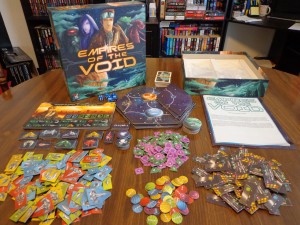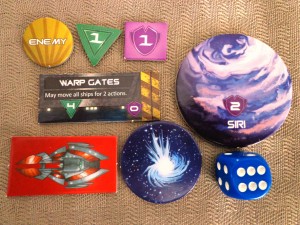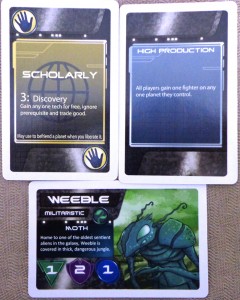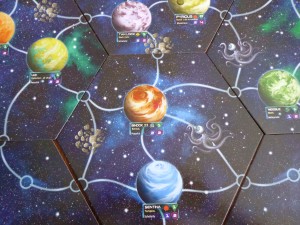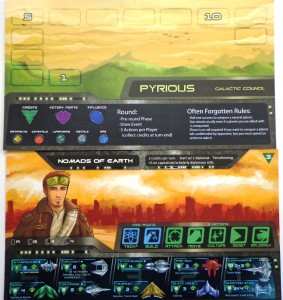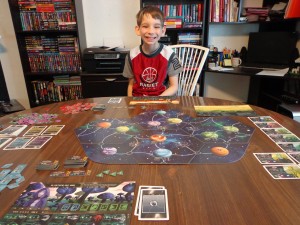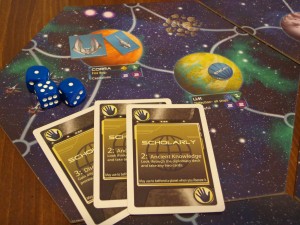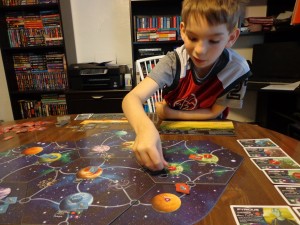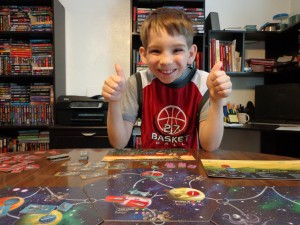I’m a big fan of 4x turn based space games…Galactic Civilizations II, Birth of the Federation, and Endless Space, just to name a few. I’ve always enjoyed having the ability to shape and mold my civilizations the way I like…whether that is to research ways to set my economy well above the rest or to rule the galaxy with an iron fist. Needless to say, I was happy to see Empires of the Void arrive on my doorstep.
Empires of the Void is a space-themed game that tasks players with earning the most victory points. To do that, players will be fighting for control over planets, trying to gain influence with other races, and researching technology. Before I begin, I’d like to thank Dan Yarrington from Game Salute for sending me a free copy to review.
Components
Galaxy & Home Planet Boards – These boards make up the main playing area, where players will be moving their ships and performing various actions.
Player Boards – Each player receives one of these, but each one lists out a unique race along with their attributes. Player boards also list out the kinds of ships one can buy, along with the actions players can perform.
Galactic Council Board – This particular board keeps track of a player’s influence in the game. Influence is gained by forming alliances with the many neutral races that inhabit the main board.
Tokens – This game has plenty of tokens for players to use to keep track of their progress. There are ship tokens, credit tokens, victory point tokens, home planet tokens, technology tokens, alliance / enemy tokens, and more.
Cards – Planet cards, diplomacy cards, and event cards make up the different card types in this game.
Dice – Dice are used to resolve combat and diplomacy actions.
Setup & Gameplay
Normally, I’d list out all that is involved in setting up a game, but this particular game has numerous steps involved. In the interest of keeping the review moving, I’ll link the manual later on so that you can see the steps involved for yourself.
The game is played over eleven rounds. Players have that long to add as many planets as they can to their cause by conquering them or befriending them, research all the technology they can, and gain as much influence as possible in order to score victory points during the three scoring rounds.
Before a round begins, players will be able to build ships and research technology. After that is accomplished, an event card is drawn that describes a major change in the game. Some event cards give a free ship or tech to the player with the least number of planets, while others add pirates to particular planets, just to name a few examples.
Each player will be allowed to perform three actions per round. The type of actions they can perform vary and consist of the following:
Move – Move a ship up to as many spaces as their movement value allows. Some spaces on the board can’t be transversed without the required technology, though some ships are able to ignore these hazards naturally.
Attack – Use ships at a location to attack an opposing target’s planet or fleet. Each ship has its own initiative value, giving them the ability to roll and attack first. In order to hit something, ships must roll above their attack value and they attack only once per action. The defenders can attack as well per their initiative rating, but are at the mercy of dice rolls just like their attackers.
Culture – Draw a diplomacy card. Players will be using diplomacy cards to attempt to form alliances with neutral planets. They also include special actions that can be used in lieu of their diplomatic function.
Diplomacy – The player can play so many same colored diplomacy cards (the more the better) and roll dice to attempt to win over neutral planets diplomatically. Allied planets give the player influence and special abilities, in addition to the credits, trade goods, and victory points a conquered planet would give.
Mine – Gain one credit…this can only be done once per turn.
It should be noted that the above rules can be modified slightly by researching certain technologies. Some technologies unlock ships for combat, increase a player’s diplomacy card hand limit, add modifiers to dice rolls, add movement values to certain ships, and more.
At the end of the round, players earn credits equal to the amount listed on their player card plus any credits that conquered / allied planets might provide. Score cards are seeded into the event card deck before the game begins, which signal when players should score their victory points. After the eleventh round, players score victory points one final time and the game ends. The person with the most victory points after they have been tallied is the winner!
The above is just an overview of the game and doesn’t cover all of the rules, but should give you an idea of what the game is like. For more information, please view the manual here:
The Review
I’ll say this…there are PLENTY of pieces and components to ogle. I was surprised by how heavy the box was when I first picked it up, and equally surprised by how many pieces were in the box. The components themselves are full of character and represent the theme well. My son and I enjoyed looking at all of the races, the ships, the technology…pretty much everything that the game had to offer. The quality of the components are fairly good and I was overall pleased by the way they functioned.
By that same token, the average play time on the box is no exaggeration. It took me about twenty minutes to set the game up and another ten to fifteen minutes to put it all away. Vinnie (11) and I played the short game variant (two scoring rounds instead of three) to shorten our play time, but we still spent a good hour in the core game. This is definitely a game that should be played when your group is in it for the long haul…it’s not something that you can pick up and play within a half hour. First time players should definitely set aside some extra time to account for the learning curve. Families can play and enjoy this game, but I can see this game appealing more to people that enjoy long, in-depth strategy games.
Vinnie and I played a two player game and we both had a fun time of it. I concentrated on researching technologies that increased my hand limit and added modifiers to my diplomacy rolls so that I could gain alliances more easily. I was hoping to increase my influence and gain victory points in the process, but my son’s ships quickly made their way towards planets I had already won over. Where I had focused on diplomacy, he had focused on the military, researching the bigger ships that plowed their way through my fleets. In the first scoring round, I had a decisive advantage as I expanded and gained alliances quickly, but the tides turned toward the end when I was unable to stop him from conquering the planets I had won over. Even if we had played the longer game, I’m confident he would have kept with his lead despite the points I scored via technology and alliances. He simply had too many planets under his control and he was earning a good amount of credits to replace his losses.
All in all, Empires of the Void is a great game that has a lot to offer. Its complexity may scare off casual players, but those willing to take the time to learn the game and to play it may find it to be quite an enjoyable experience. If you decide to take the plunge, be sure to have a big table and plenty of open slots available on your schedule book…you’ll need it!
Final Verdict: 7/10
You can read more about “Empires of the Void” by visiting the following websites:

